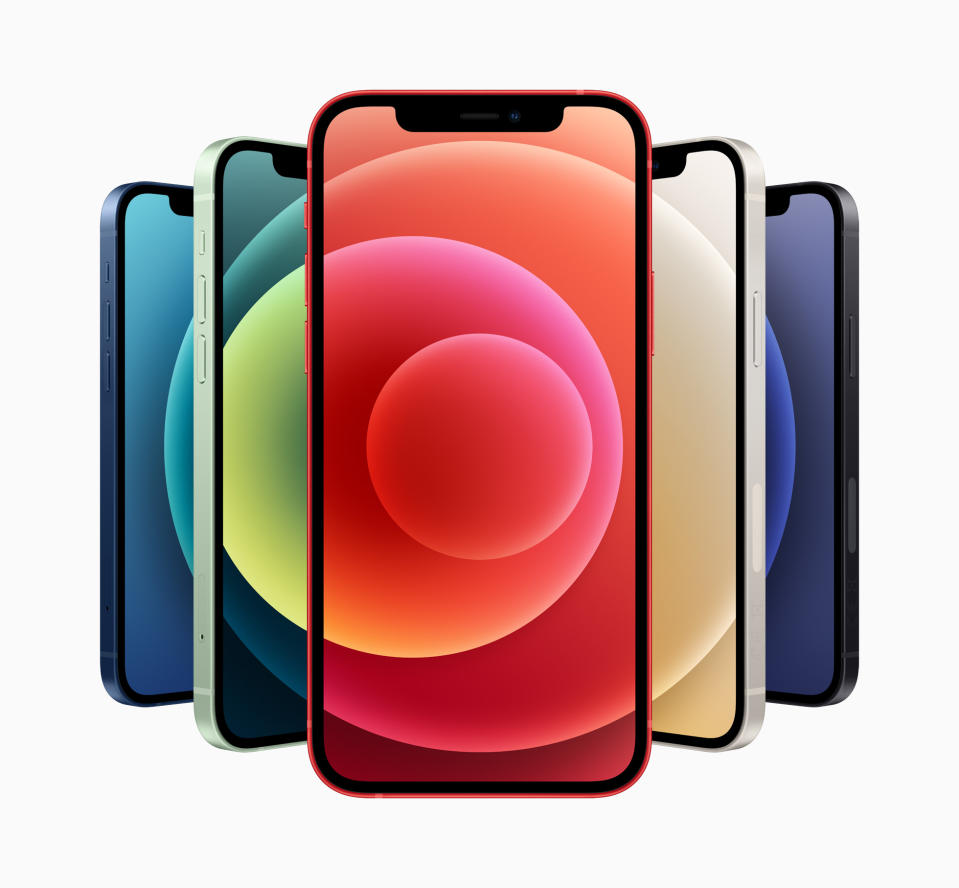The iPhone 12 has 5G and a new flat-edged design
The leaks were right on.
To the surprise of almost no one, Apple today has pulled the wraps off its next set of iPhones. The new iPhone 12 is set to replace last year’s iPhone 11 as the default choice for most people, a mix of the best features from Apple’s more expensive phones while still having a reasonable price. As expected, the iPhones 12 keeps the 6.1-inch screen size that was found on the iPhone XR and 11, but this year Apple has finally put an OLED display in its more affordable iPhones. It also has a new design that looks a lot like the iPad Air, with squared-off edges instead of the rounded ones we’ve seen on iPhones for several years now.
While the screen size is the same, Apple says the iPhone 12 is smaller than the 11 in all ways; it’s thinner, with smaller screen bezels and slightly less overall weight. That’s thanks in part to the OLED display, which takes up less room. It also significantly improves the screen resolution over the iPhone 11: 2532 x 1170, which works out to 460 pixels per inch.That’s a huge upgrade over the older iPhone XR and 11. Apple has also improved the glass on the front with a “ceramic shield” through a partnership with Corning. The company says that the screen is four times more drop resistant than it was before.
In a big nod towards future-proofing, the iPhone 12 will include 5G connectivity, a first for an iPhone. As expected, the iPhone 12 works with the “sub-6” spectrum that is more widely deployed currently. In the US at least, the iPhone 12 will also work with mmWave 5G networks — that’s currently the only 5G network that Verizon, the biggest US carrier (disclosure: and Engadget’s parent company) currently uses. Given that Apple certainly doesn’t want to worry about splitting hairs between different types of 5G, it makes sense to see it on board here.
Unsurprisingly, the iPhone 12 is powered by Apple’s A14 Bionic chip that was announced last month with the latest iPad Air. It’s similar to the A12 and A13 before it in that it combines six CPU cores (two high-performance, four lower-power for better energy efficiency) and four GPU cores. But for the first time, the A14 is built on a 5nm fabrication process, which essentially means they’re more densely packed with transistors. Specifically, the A14 includes 11.8 billion transistors, up from the 8.5 billion in the A13. What this means for you, dear reader, is that the A14 should be about 15 percent faster than the A13 while using 30 percent less power.

Between the A14 chip and 5G network support, Apple used this opportunity to announce a new partnership with Riot Games, which will bring League of Legends to the iPhone. Specifically, it’s a mobile version called League of Legends: Wild Rift.
The iPhone 12 features a new standard wide camera with an f/1.6 aperture and a seven-element lens alongside the same ultra-wide camera that was in the iPhone 11. Apple says that the standard camera has a 27 percent improvement in low-light performance compared to last year’s iPhone. On the video front, the larger aperture will allow for more detail in low light, as well. And there’s a new night mode time-lapse feature which Apple showed off in a demo video shot around Las Vegas. This is the kind of thing we’ll need to try ourselves, but the time lapse feature looked pretty impressive in the demo.
Naturally, the iPhone 12 has wireless charging, but the back also has new magnetic sensors that allow for some pretty neat tricks. Specifically, MagSafe for iPhone lets iPhone chargers snap right into place. It looks like Apple is also making some magnetic accessories like a credit card case that snaps to the back of the phone, for example. As for that MagSafe charger, it looks basically like a large MagSafe charger from the Apple Watch. Speaking of the Watch, Apple is also making a dual charger for the iPhone and Apple Watch that folds up easily for travel.
On the environmental front, Apple is taking the same move that it did last month when it removed the power adapter from the Apple Watch. It’s also removing the Lightning headphones from the box, as well. As before, Apple says it’s doing so to reduce the manufacturing needed for such products; it also means the boxes are smaller so they can ship things more efficiently. It’s also using 100 percent recycled rare earth materials for the first time. Apple says the changes it made to the iPhone 12 are the equivalent of removing 450,000 cars from the road. On the plus side, the iPhone 12 will come with a USB-C to Lightning cable for fast charging, something that wasn’t standard before.
The iPhone 12 will cost $829 at launch with 64GB of storage, though it’ll be $799 if you buy and activate with AT&T or Verizon here in the US. 128GB and 256GB models are also available. The colors this year are black, white, red, green and blue. It goes on pre-sale this Friday, and will be fully available as of Friday, October 23rd.
Update, 4PM ET: This story has been updated with more pricing details about the iPhone 12 on Verizon and AT&T.

 Yahoo Lifestyle
Yahoo Lifestyle 